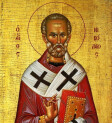
December is a time of Advent, celebrations, familiar carols, decorated trees, homes and yards, but (appropriately enough), this is also a time of the Feast of Saint Nikolaos of Myra — aka Saint Nick or as so many in the western world have come to know him … Santa Claus!
Born sometime between 260 and 280 A.D. in Patara, part of Asia Minor (modern-day Turkey), Nicholas lived during a time when Christians were persecuted but also during a time when Christianity ultimately became the accepted faith. Nicholas came from a wealthy family, but was orphaned at a very young age when his parents died during a plague. Nikolaos received a substantial inheritance and was raised by his uncle, the Bishop of Patara. Eventually, Nikolaos became a bishop himself, serving in the ancient Greek city known as Myra, also located in modern-day Turkey.
Under the Roman Emperor Diocletian, who ruthlessly persecuted Christians, Bishop Nicholas suffered for his faith, was exiled and imprisoned. … After his release, Nicholas attended the Council of Nicaea in AD 325. He died December 6, AD 343 in Myra and was buried in his cathedral church, where a unique relic, called manna, formed in his grave. This liquid substance, said to have healing powers, fostered the growth of devotion to Nicholas. The anniversary of his death became a day of celebration, St. Nicholas Day, December 6th (December 19 on the Julian Calendar).
Ministering to the early Christian community, he took to wearing red clerical robes. He is said to have encouraged a culture of generosity among the people he served, saying “The Giver of every good and perfect gift has called upon us to mimic God’s giving, by grace, through faith and not of ourselves.” Many tales surround Nikolaos’ own legendary generosity, none more poignant than that of three young sisters and their impoverished father.
One story tells of a poor man with three daughters. In those days, a young woman’s father had to offer prospective husbands something of value—a dowry. The larger the dowry, the better the chance that a young woman would find a good husband. Without a dowry, a woman was unlikely to marry. This poor man’s daughters, without dowries, were therefore destined to be sold into slavery. Mysteriously, on three different occasions, a bag of gold appeared in their home-providing the needed dowries. The bags of gold, tossed through an open window, are said to have landed in stockings or shoes left before the fire to dry. This led to the custom of children hanging stockings or putting out shoes, eagerly awaiting gifts from Saint Nicholas. Sometimes the story is told with gold balls instead of bags of gold. That is why three gold balls, sometimes represented as oranges, are one of the symbols for St. Nicholas. And so St. Nicholas is a gift-giver.
One version of the story says that the father waited up one night to see who this elusive gift-giver was who was throwing gold through the window. Nicholas, crafty in his generosity, tossed his final bountiful gift through the chimney so as to avoid detection. Various miracles were also attributed to Nikolaos (and his relics, or remains) in the following centuries; he was eventually recognized as a saint, and considered a patron saint of children, sailors, merchants, thieves, and pawnbrokers!
To honor him and his legacy, people around Europe in the Middle Ages exchanged gifts on the day of his death, December 6. In time, stories of his generosity and miracles traveled the globe. Saint Nikolaos became known to many as “Saint ‘Klaus,”… aka Santa Claus. And now you know…the rest of the story. You can read more stories and find out more about his amazing life at www.stnicholascenter.org.
Oh, that in this season, we might live into the words that Paul spoke to the elders at Ephesus in Acts 20:35, “…remember the words of the Lord Jesus, how he himself said, ‘It is more blessed to give than to receive.’” How do we maintain a finely-tuned conscience that seeks to live generously and boldly, even expressing a generous life in clever generosity as did Saint Nicholas.
May the spirit of Christ and the example of generous Nicholas remain with you this Advent and Christmas season as you discover fresh expressions of radical generosity.
-Pastor Jerry
The content for this blog came from several sources, including www.stnicholascenter.org.
